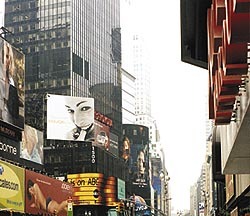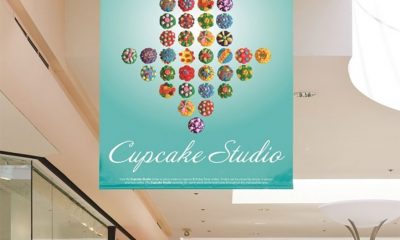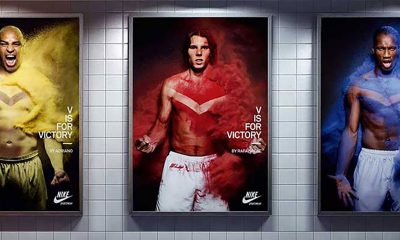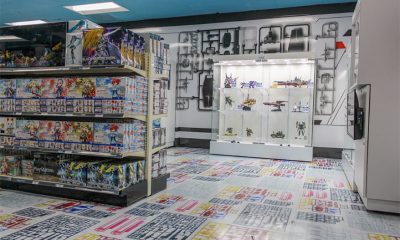Banners + Awnings
Flex in the City (and Everywhere Else)
Flexible-face signage is all around you. Here’s how to make money with this product.
Published
18 years agoon
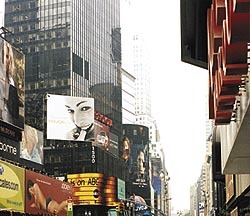
Pet rocks, disco and the Village People. These may be pop culture's most notable '70s-era contributions. But in the world of signage, one of the most significant products introduced during the flower-power decade was flexible-face fabric.
Since its inception, flexible-face fabric has been used in virtually all niches of the industry — from cabinet signs, channel letters and banners, to billboards, truck graphics and Times Square spectaculars.
Despite its range of uses and nearly 30-year history, the product is still misunderstood by some signmakers. Many believe the fabric is only a material used by "the big boy" sign companies. But this is not necessarily true. Shops of all sizes can effectively use the product to make signs — and more importantly, money.
To do so, it's helpful to understand just what flexible-face fabric is, when it's appropriate for a job, how to decorate and install it and how to market it.
Flex education
Most flexible-face material comprises a polyvinylchloride (PVC) surface attached to a scrim of woven nylon or polyester. Some manufacturers create the material by casting, which is the same process used to make certain pressure-sensitive, adhesive-backed film. Other manufacturers extrude the fabric using a high-temperature process to permanently bind the vinyl and scrim.
AdvertisementThe material is offered in a range of thicknesses, tear-strengths and UV-resistance options. For example, fabric used in non-vertical applications on awnings typically needs greater UV resistance than fabric applied vertically on sign faces.
Certain materials are also created to accommodate specific decoration methods — pressure-sensitive vinyl, digital imaging, painting, eradication and the like.
Flexible benefits
Flexible-face fabric was created as an alternative to rigid acrylic, polycarbonate and other rigid-plastic substrates. According to product manufacturers, one of the product's primary benefits is its imperviousness to vandalism.
"If you throw a beer bottle at a flexible-face sign, the bottle will bounce right off. If you throw it at a rigid-face sign, the acrylic will likely crack or shatter," says Brian Brooks, president, ABC Sign Products Inc. (Fort Collins, CO). Some fabrics also have coatings that allow spray-painted graffiti to be wiped off with thinner, he adds.
Another advantage of flexible-face material is its wind strength. "Flexible faces in the wind are like trampolines. If you jump on the trampoline with your body weight, it bends under the 200 lbs. of force. But as soon as your weight is released, it returns to its original shape," Brooks says.
AdvertisementEven though the fabric retains its shape, for extremely large flexible-face signs Brooks recommends installing a deflection grid of tensioned, lightweight, plastic-coated, steel guy cables — in checkerboard fashion — 3 or 4 in. behind the face and in front of the sign lamps. Doing so relieves stress on the face's tensioning system and sign cabinet and prevents the fabric from pushing against the sign lamps in very strong wind.
A third plus the fabric offers is its whiteness. Certain brands of flexible-face materials are reportedly whiter than rigid acrylic or polycarbonate sheeting. "The fabric affords true-color, bright-looking copy," says Bernie Ostrenga, sales and marketing manager for World Wide Sign Systems Inc. (Bonduel, WI). This is enhanced by adding mildew-resistant chemicals to the fabric, says Allan Hobden, general manager of Selkirk Signs and Services Ltd. (Cranbrook, British Columbia, Canada).World Wide Sign Systems Inc.
A fourth benefit is size. "To make a one-panel sign, you can roll the fabric up and take it anywhere," Hobden says. "With rigid materials, first, the material doesn't come that long. Second, you couldn't place it on a truck. Can you imagine moving a 100-ft. plastic face on a truck?" Hobden says one use perfect for flexible-face signs is in the fascia canopies of gas stations, which are often as long as the building.
Flex time
According to Brian Lynch, marketing manager for Ultraflex Systems Inc. (Rockaway, NJ), flexible-face fabric is price-competitive in sign-cabinet applications that exceed 5 x 10 ft. In such instances, the fabric is often more economical than plastic because many rigid substrates come in 6-ft. widths. Not surprisingly, however, fabric price varies according to its durability. "Cost depends on the quality of the fabric — the amount of PVC that's involved, the number of yarns per sq. in. and whether or not a topcoat is added," Lynch explains.Ultraflex Systems Inc.
Because of the fabric's wind-resistance, Ostrenga recommends using it in high-rise, pylon-type signs where blowout is a problem. While translucent flexible fabric can also be used on large channel letters and spectaculars, opaque fabric is ideal for building wraps, billboards and vehicles — thanks to special truck tensioning systems.
AdvertisementFabric-ation methods
In addition to good ol' fashioned white, manufacturers offer fabrics in a variety of standard colors. And, for large projects with multiple locations, some manufacturers will match PMS colors, Ostrenga says.
With regard to fabrics created for specific decoration methods, "There are many flexible-face alternatives out there," Brooks says. "Panaflex® from 3M Commercial Graphics Div.(St. Paul, MN) and Cooley Brite® from Cooley Sign & Digital Products (Pawtucket, RI) are two widely used and are both high quality. We sell both of these brands at ABC, and also Awnoflex®, Signoflex® and Awnoflex Plus® — all made to sufficient weight and strength and UL-recognized. Flexface® from Arlon-Signtech Ltd. (San Antonio) is also popular. And Ultralon IV® from Ultraflex Systems Inc. is unique because it comes without seams in widths greater than 2 meters."Cooley Sign & Digital Products, Arlon
Brooks explains that nearly all of these fabrics accept pressure-sensitive, adhesive-backed film, which he estimates to be the most common decoration method. 3M's Scotchcal® film, he adds, is an especially popular film applied to flexible fabric. This popularity will likely continue, Ostrenga projects, because 3M has introduced 3632 Scotchcal film, which has a built-in "graphic protection system" (GPS clearcoat).
In addition to pressure-sensitive film application, digital printing is an increasingly popular decoration option for flexible materials. In fact, many printer manufacturers offer a list of fabric types that can be successfully used with their equipment and inks.
Thanks to automated large-format, screenprinting presses, screenprinting is a viable decoration method for quantity jobs. And eradication is used to decorate Cooley Brite and other eradicable fabrics.
Two other decoration options are heat transfer and paint. Heat-transfer decoration requires using paint-on-paper (heat-transfer material) and a large applicator to press the paint-on-paper onto the substrate — similar to a giant T-shirt press. This method allows for economical decoration of complex logos. Some flexible-fabric manufacturers offer a nine-year warranty on heat-transfer decorated faces.
When it comes to painting fabric, signmakers mask and spray specially formulated vinyl-based ink. For increased durability, they then spray on a clearcoat compatible with the ink.
"Before painting, consult with ink and fabric manufacturers," Brooks advises. "Be sure the fabric is suitable for paint application; not all are. Our Awnoflex Plus product, for example is formulated for pressure-sensitive graphics. It has a protective Tedlar® coating, so paint won't adhere. Signoflex, in contrast, is a product formulated for paint and screenprinting applications, but not pressure-sensitive film."
Avoiding Tension Headaches
How you install fabric in a sign cabinet depends on what type of extruded aluminum cabinet you're using. It also depends upon your fabric-tensioning system of choice. "We have a patented tensioning system that's part of our extrusions. It doesn't take special shop equipment — just some elbow grease and a blunted screwdriver or chisel," Brooks says. "Other companies offer ratcheting or click-in systems. There are advantages and disadvantages to each method."
Lynch says his company, Ultraflex, is among those offering an aluminum tensioning system.
"Cabinet-extrusion suppliers and also 3M provide very good instructional literature that explains how to tension the face and outlines important procedures," Ostrenga adds.
When signmakers don't follow a tensioning system's directions precisely, problems can occur. For example, sometimes signmakers cut a face too small, then have to over-tension to compensate for inadequate material size. But when you secure the fabric too tight, you run the risk of ruining the face, tensioners or cabinet.
Conversely, if you keep the material too loose, the face will flop back and forth. Plus, you run the risk of ruining the tensioning devices or the face.
Not only do systems exist for creating flexible-face signage from scratch, many companies offer retrofit extrusions. These extruded aluminum "tracks," which attach to cabinets originally created for use with rigid-plastic faces, provide a foundation for flexible-face tensioning systems.
Ostrenga advises carefully checking building specs when installing a backlit flexible-face sign on a building. "Make sure the wall and support structure behind it are capable of withstanding the sign's weight. Then, be sure to anchor the material well to whatever support structure exists," he says.
Flex and balances
The fabric and technology used to produce large banners on buildings is similar to those used for producing backlit flexible-face signage. However, in many cases, building banners comprise lighter-weight fabric. Plus, longevity isn't as much of a concern for a six-month banner, compared to a five- to seven-year, on-premise sign.
When installing a banner, Lynch suggests tensioning the fabric using fiberglass tubing in pole pockets because grommets may rip the fabric.
Flexing muscle
Certainly, outdoor durability is a vital concern for flexible-face signage. Like any signs, they need to resist fading from ultraviolet rays and endure exposure to water, wind, pollution and other sign "enemies." As such, some fabrics have built-in protective clearcoats. Others require that protective clear laminates be heat-transferred to their surface.
According to Brooks, most flexible-face fabrics designed for vertical applications in typical outdoor settings come with five-year warrantees. He says there are some eight- and nine-year products as well — Awnoflex Plus and certain products from 3M and Cooley, for example.
3M's nine-year warranty, says Ostrenga, is offered when you use the company's Scotchcal 3632 GPS vinyl and flexible-face substrate in combination. A nine-year warranty is also offered by 3M for heat-transfer applications.
Arlon-Signtech's Superglasskote® chemical topcoat reportedly affords good protection against the environment. And 3M offers UV-resistant overlay film for hand lamination. "Some people use overlaminates; many do not. Overlaminates do increase the price of sign faces. But for customers concerned about longevity, they're worth it," Brooks says. He cautions, "When signmakers quote a job with an overlaminate, they may not be the low bidder. So they need to educate customers about the benefits it provides and how to compare apples to apples rather than apples to oranges. Remember, there are quality buyers, and there are price buyers."
Ironically, sign maintenance is a common issue that adversely affects flexible-face durability. "Sign repairmen frequently try to un-tension a flexible face in the field so they can service the electrical components inside the sign. But usually, it's not necessary," Brooks says. "A repairman typically isn't as familiar with a sign's tensioning system. About the time he's facing a 50-mph wind, he realizes it's not as easy to tighten the face in the field as it is in the shop, where conditions are ideal. So he leaves wrinkles and puckers in the face when he puts it back in place."
He adds that most quality extrusion systems can be serviced without untensioning the flexible face. By loosening a few screws, you can usually remove a perimeter cover or hinge an outer frame for service access. Other large sign cabinets may have doors cut in their sides for accessibility.
Flex sells
In the world of flexible-face signage, there's money to be made. However, many small signshops are intimidated by this business niche. They shouldn't be.
"Any signshop can do it — they just may be limited to how much of the work they can do in-house," Brooks says. "A three- or four-person shop could purchase a piece of fabric — although a small piece will be more expensive than a full roll — and apply vinyl lettering themselves. After all, they'll likely already have vinyl, a squirt bottle [for wet vinyl application] and knife-cutting equipment on-hand."
If a face is large enough that multiple pieces of fabric need to be seamed together, the signshop can then hire a wholesaler — most of whom use dialectric heatseal equipment — to create the blank, seamed face. The shop can then apply vinyl to that surface. Or, if a signmaker doesn't want to be bothered with any face decoration at all, he can hire a wholesaler for that work as well. In addition to vinyl application, many wholesalers offer digital printing, screenprinting, eradication, heat transfer and other decoration services.
Once a flexible face has graphics applied to it, a signshop can easily tension the fabric in-house by carefully following manufacturers' instructions.
When it comes to fabricating and engineering a large sign cabinet for a flexible-face sign, Ostrenga offers words of caution. "It's a major leap to go from making a 4 x 8-ft. sign 20 ft. off the ground to a 10 x 20-ft. sign nearly 100 ft. up in the air. It's difficult to meet all engineering and wind conditions," he says. "If you don't have the equipment or expertise to engineer a large sign, stay away from doing so; it could be costly. You're better off to outsource the sign cabinet work."
How should flexible-face signage be marketed? Brooks suggests showing the fabric's available colors. Have photos and brochures on-hand as well, and play up the material's advantages — wind and vandalism resistance, for example. Customers are always concerned about price, so also talk about the material's cost-effectiveness in large applications. Finally, highlight the fabric's ability to display crisp, colorful images.
"Flexible-face signage affords brilliant images at an affordable cost," Lynch concludes.

SPONSORED VIDEO
Introducing the Sign Industry Podcast
The Sign Industry Podcast is a platform for every sign person out there — from the old-timers who bent neon and hand-lettered boats to those venturing into new technologies — we want to get their stories out for everyone to hear. Come join us and listen to stories, learn tricks or techniques, and get insights of what’s to come. We are the world’s second oldest profession. The folks who started the world’s oldest profession needed a sign.
You may like

INX Promotes Three to Vice President

6 Sports Venue Signs Deserving a Standing Ovation

Hiring Practices and Roles for Women in Sign Companies
Subscribe

Bulletins
Get the most important news and business ideas from Signs of the Times magazine's news bulletin.
Most Popular
-

 Tip Sheet4 days ago
Tip Sheet4 days agoAlways Brand Yourself and Wear Fewer Hats — Two of April’s Sign Tips
-

 Business Management2 weeks ago
Business Management2 weeks agoWhen Should Sign Companies Hire Salespeople or Fire Customers?
-

 Women in Signs2 weeks ago
Women in Signs2 weeks ago2024 Women in Signs Award Winners Excel in Diverse Roles
-

 Real Deal5 days ago
Real Deal5 days agoA Woman Sign Company Owner Confronts a Sexist Wholesaler
-

 Benchmarks21 hours ago
Benchmarks21 hours ago6 Sports Venue Signs Deserving a Standing Ovation
-

 Editor's Note1 week ago
Editor's Note1 week agoWhy We Still Need the Women in Signs Award
-

 Line Time2 weeks ago
Line Time2 weeks agoOne Less Thing to Do for Sign Customers
-

 Product Buying + Technology1 week ago
Product Buying + Technology1 week agoADA Signs and More Uses for Engraving Machines
